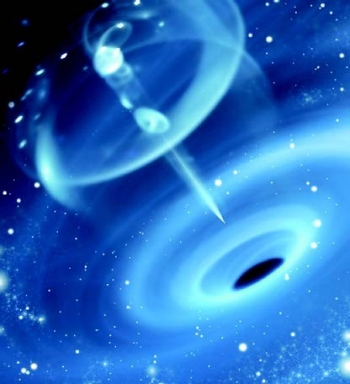Gravitational Waves Finally Detected

By Mike Howie
Einstein has been proven right once again.
Researchers at the Laser Interferometer Gravitational-Wave Observatory, or LIGO, have detected gravitational waves, the last part of Einstein’s theory of relativity that had yet to be proven. The waves they detected were created over a billion years ago, when two massive black holes collided to form one even larger black hole in a distant part of the universe.
What are Gravitational Waves?
Every object, no matter how large or how small, creates a gravitational field. Large objects, like planets and stars, create large gravitational fields. Small objects, like a person or a car, create gravitational fields so weak that they might as well not exist. What we experience as gravity is actually a distortion in space-time. The best way to illustrate this is with a stretched sheet. The sheet is space-time, and anything you place on the sheet is an object in the universe. A large, heavy object will produce a large dent in the sheet, while a smaller, lighter object will produce only a small dent. Those dents are gravitational pull that objects can get stuck in – they’re the reason a smaller object, like a planet, orbits a larger object, like a star.
But the objects in our universe don’t sit in one position in space. They move around, taking their dents in space-time with them. When these objects move through space they produce ripples in space-time, similar to the way a boat produces ripples in water as it sails along. As the waves move through space, they stretch and compress whatever they pass very slightly. For the most part, these waves are so miniscule that they’re basically zero.
However, there are some objects that create gravitational waves large enough that we can detect them. Black holes have immense gravitational fields, so large that not even light can escape. And when they collide they create an explosion that produces larger gravitational waves than either black hole could create independently. But, just like ripples in a pond, the waves get smaller and smaller the farther and longer they travel. By the time the waves recently detected reached Earth they were so small that even a car driving over a speed bump could produce interference.
How’d They Do It?
Detecting something so minute takes a lot of hard work and advanced equipment. LIGO used two different facilities in their experiment, one in Louisiana and one in Washington State. Each facility consists of two vacuum-sealed tubes, each four kilometers (2.5 miles) long, that form an "L." A laser is fired and split to go down each tube. At the end of each tube there is a mirror that bounces the laser back to its origin. When a gravitational wave passes these mirrors, it distorts space-time temporarily, making one mirror farther from the origin than the other. Based on how long it takes the laser to return, the researchers can detect whether or not a gravitational wave has passed.
It’s a simple premise, but the equipment has to be incredibly precise to detect something as slight as a gravitational wave. The waves moved the mirrors by only 1/10,000 the size of a proton. That’s why it’s so important to have two facilities. In order to weed out any kind of interference, the findings from one facility need to match the findings from the other.
Now What?
Proof that gravitational waves really do exist gives more reason to keep researching them, which means advancing the ways in which that research is conducted. One of the best ways to do that is to get the research equipment off of Earth, where it has a plethora of interference to deal with, and into space. There would be far fewer disturbances there, and it would grant the advantage of having a much larger detector, one that could potentially use laser beams that are millions of miles long. Using such vast distances means the variation in positioning would be larger, and therefore easier to detect.
The knowledge that these waves are out there changes the way scientists look at the universe. In the same way that radio waves and x-rays presented new ways to see and study the universe, gravitational waves present a way to study objects that don’t emit any kind of light but are thought to radiate gravity, such as black holes. It could even provide a way of studying the Big Bang from a new perspective, shedding greater light on how our universe was created.


